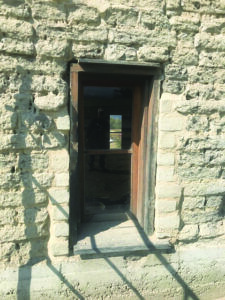
Fort Owen State Park in Stevensville is a small but significant piece of Montana history. The one-acre park, located along the Stevensville Cut-off Road and surrounded by a private ranch, is the site of one of Montana’s earliest trading posts. Although it was called “Fort” Owen, it was never a military installation. The property was purchased by John Owen, who was married to a Native woman, and they ran the commercial center for 10 years, welcoming all who came through its gates. Operating as a state park for many years, it has only been in recent years that attention has focused on the deteriorating condition of the remaining structure on the property, due in part to the efforts of the local non-profit Friends of Fort Owen.
That structure is the “east barracks” which is one of very few historic structures in Montana made from adobe bricks.
Solomon Martin, owner of Zoula Services, was hired by Montana Fish, Wildlife and Parks, which manages Fort Owen State Park, to repair and stabilize the east barracks. Martin, who specializes in historic masonry, and his crew of five, have been working at the park since mid-June. All the materials they are using in the project are locally sourced. For the wood products, they have utilized Log to Lumber, a Stevensville company. One of the challenges has been to find the right clay soil for the adobe mixture to match the original adobe. Eventually they found a close match at Yoder Gravel off the Eastside Highway. That, mixed with chopped straw, manure and wood ash, and the right amount of water, turned out to be the ticket.


Nora Hysell, one of Martin’s crew members, is in charge of making the adobe bricks. Martin estimates that Hysell has likely made about 500 bricks for this project so far. Each brick is stamped with a “Z” for Zoula, which will allow historians of the future to differentiate between different time periods of repair.
Martin said that he and his crew met with Alex Lim, an expert on adobe, “who basically put us through adobe school. That, plus my own experience, resulted in the end product which was developing this recipe specific to this place and application.”
Adobe is basically any unfired brick, said Martin, but all soils are different, so you have to find the right mix. “Our recipe works and is consistent with the historic bricks that were used here.”
According to Philip Maechling, a volunteer with Friends of Fort Owen, the original clay that was used to build Fort Owen was from somewhere on what is now a private ranch. He said that after a newspaper article ran that mentioned their search for native clay, they got numerous calls about possible sites. Eventually, someone told them about some clay at Yoder Gravel Pit and it turned out to be the right kind. Fortunately, it was something the company had no use for.

Maechling said that this “tertiary clay” is roughly 1-½ to 2 million years old, and could possibly be running in a strata that is connected to the ranch site. “It’s the same or almost the same,” said Maechling.
Adobe is an unusual building material in Montana and nobody is really sure why. In the case of John Owen, Maechling said that Owen often traveled to Fort Hall in what is now Idaho to purchase supplies. Fort Hall and also Fort Boise, built by the Hudson’s Bay Company, were both made of adobe and Maechling believes that Owen thought it was the “proper” material for a fort.
“These walls are 170 years old,” said Maechling. He said the oldest known adobe walls were built in Mesopotamia around 10,000 years ago. The technology was brought to Spain by the Moors, then by the Spanish to what is now Mexico, then from there to what is now the American Southwest. “So, it’s a 10,000 year old technology from Mesopotamia that ended up in Stevensville.”

Repairs have been made both inside and out. The east wall of the east barracks, where most of the deterioration is, is being repaired in the least disruptive manner possible so as not to compromise the historic values. The 18-inch wall contains an estimated 5000 bricks. Martin estimates that it took 5-600 tons of material to build the east barracks, all the work done by hand. Martin is clearing out areas where bricks have broken and fallen out and replacing them with new bricks. Oakum, a clay or tar infused rope, is used to fill in between the wooden window casements and the adobe. A number of small voids, or worn-down indentations, are being left alone.
“The least damage possible to the original materials is the goal,” said Maechling. “These guys are like adobe surgeons.”
Martin said that working in historic preservation is not something that many contractors like due to the challenges presented by old construction and the ravages of time. “But I’m a little bit allergic to rectangles,” he said. “It’s nice to take on projects where you’re doing something different all the time. That’s what’s so nice about historic preservation.”
Martin said it will take them about three more weeks to complete the project.
Victoria Howell can be reached at editor@bitterrootstar.com